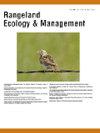Monitoring of Fire-Affected Buildings and Air-Quality Assessment: A Remote-Sensing Study Using Ground-Based interferometric Radar and Google-Earth-Engine
IF 2.4
3区 环境科学与生态学
Q2 ECOLOGY
引用次数: 0
Abstract
This study investigates the environmental and structural impacts of crop and rangeland residue burning in Punjab during April and May 2023, utilizing ground-based interferometric radar alongside atmospheric and land use datasets. The radar system was employed to monitor structural deformations in buildings affected by fire, providing critical insights into the broader impacts of the fires on infrastructure. Multiple ground-based interferometric radars for distributed monitoring can effectively obtain the three-dimensional deformation components of structural targets in real fire scenes. The monitoring results conform to the displacement variation law of existing portal steel frame structures during fire deformation, and can provide effective data support for building structure collapse warning under fire. This approach offers a novel method for assessing the structural integrity of buildings during and after fire events, complementing traditional environmental monitoring. Environmental data show a marked increase in atmospheric pollutants such as NO2, CH4, and CO in May 2023, directly linked to the residue burning. Active fire data from FIRMS and MODIS revealed a 98% increase in fire events compared to April, while land surface temperature analysis showed a rise of 1.54%, with affected areas reaching up to 45.9°C. LULC analysis indicated a 23.3% decrease in cropland and rangeland areas, reflecting extensive land clearing. These findings highlight the urgent need for sustainable agricultural management and policies to mitigate the environmental and infrastructural damage caused by residue burning in Punjab.
火灾影响建筑物监测和空气质量评估:基于地面干涉雷达和Google-Earth-Engine的遥感研究
本研究利用地面干涉雷达以及大气和土地利用数据集,调查了2023年4月至5月期间旁遮普农作物和牧场秸秆燃烧对环境和结构的影响。雷达系统用于监测受火灾影响的建筑物的结构变形,为火灾对基础设施的广泛影响提供关键见解。多台地面干涉雷达分布式监测能够有效获取真实火灾场景中结构目标的三维变形分量。监测结果符合既有门式钢框架结构在火灾变形过程中的位移变化规律,可为火灾下建筑结构倒塌预警提供有效的数据支持。这种方法为评估火灾期间和火灾后建筑物的结构完整性提供了一种新的方法,补充了传统的环境监测。环境数据显示,2023年5月大气中NO2、CH4和CO等污染物显著增加,与残渣燃烧直接相关。来自FIRMS和MODIS的活跃火灾数据显示,与4月份相比,火灾事件增加了98%,而陆地表面温度分析显示上升了1.54%,受影响地区高达45.9°C。LULC分析表明,农田和牧场面积减少了23.3%,反映出大面积的土地清理。这些发现突出表明,迫切需要制定可持续农业管理和政策,以减轻旁遮普残渣焚烧对环境和基础设施造成的破坏。
本文章由计算机程序翻译,如有差异,请以英文原文为准。
求助全文
约1分钟内获得全文
求助全文
来源期刊

Rangeland Ecology & Management
农林科学-环境科学
CiteScore
4.60
自引率
13.00%
发文量
87
审稿时长
12-24 weeks
期刊介绍:
Rangeland Ecology & Management publishes all topics-including ecology, management, socioeconomic and policy-pertaining to global rangelands. The journal''s mission is to inform academics, ecosystem managers and policy makers of science-based information to promote sound rangeland stewardship. Author submissions are published in five manuscript categories: original research papers, high-profile forum topics, concept syntheses, as well as research and technical notes.
Rangelands represent approximately 50% of the Earth''s land area and provision multiple ecosystem services for large human populations. This expansive and diverse land area functions as coupled human-ecological systems. Knowledge of both social and biophysical system components and their interactions represent the foundation for informed rangeland stewardship. Rangeland Ecology & Management uniquely integrates information from multiple system components to address current and pending challenges confronting global rangelands.
 求助内容:
求助内容: 应助结果提醒方式:
应助结果提醒方式:


